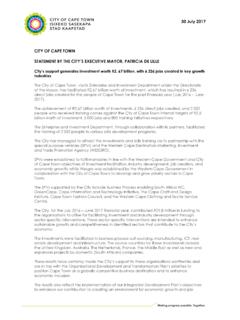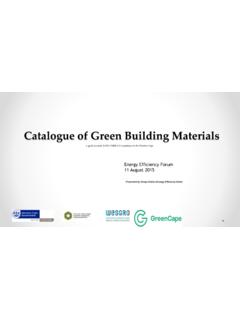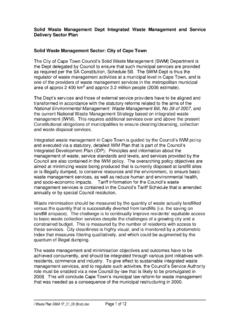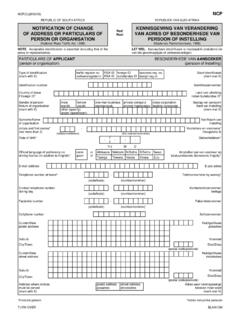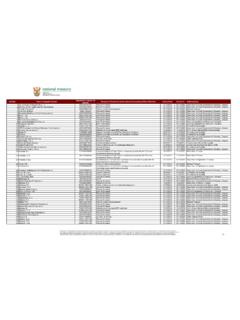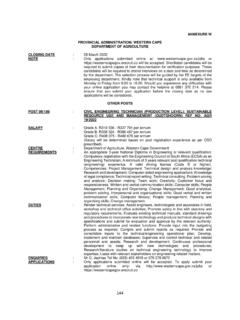Transcription of CATCHMENT, STORMWATER AND RIVER MANAGEMENT ... - …
1 CATCHMENT, STORMWATER AND. RIVER MANAGEMENT STRATEGY : FINAL DRAFT. [Approved by Council : 22/07/02]. City of cape town DEVELOPMENT SERVICE. Transport, Roads & STORMWATER Directorate CATCHMENT, STORMWATER AND. RIVER MANAGEMENT . STRATEGY 2002 - 2007. Second and Final Draft May 2002. Table of Contents Foreword .. 3. Document Overview and 3. Executive 4. 1. Situational Analysis ..6. Geographic and Socio-Economic Historic Approach to STORMWATER Environmental Drivers ..6. Customer Needs ..7. Contemporary Catchment, STORMWATER and RIVER MANAGEMENT Practice in cape 2. Institutional Mandate ..9. Local Government Reforms ..9. Core Business Definition ..9. Functional Areas ..9. Service Delivery Mechanisms ..10. 3. Strategy Context ..11. City Vision and Priorities ..11. Relationship to Other Sectoral Strategies ..12. 4. Goals and Outcomes ..13. Service Vision and Mission ..13. 5. Guiding Principles ..13. 6. Sphere of 7. Strategic Focus Areas ..14. Focus Area 1 - Holistic Planning and MANAGEMENT .
2 15. Catchment, STORMWATER and RIVER 15. Integrated Urban Water MANAGEMENT .. 16. Focus Area 2 System Development, Upgrading and Maintenance ..16. STORMWATER MANAGEMENT Guidelines and Design Criteria for New Developments .. 16. Risk Based Approach to Upgrading and Maintenance .. 16. Infrastructure MANAGEMENT 17. Environmentally Sensitive RIVER 17. Focus Area 3 Public Safety and Environmental Protection ..17. Second and Final Draft May 2002 1. Effective STORMWATER drainage with safe and healthy rivers . Flood Disaster 17. Water Pollution Abatement .. 18. Focus Area 4 Information MANAGEMENT ..18. Information Systems .. 18. Data Bureau Services .. 18. Focus Area 5 - Regulatory ..19. Control of Development near 19. 19. Tariff Funding 19. Focus Area 6 - Relationship MANAGEMENT ..19. MANAGEMENT Integration 20. Customer 20. Staff 20. General Education Initiatives .. 21. Partnership 21. 8. Review, Evaluation and Responsibility ..21. Performance Measurement and Business Second and Final Draft May 2002 2.
3 Effective STORMWATER drainage with safe and healthy rivers . Foreword cape town , a fast growing city, faces the challenge of promoting economic and social development against the backdrop of a rapidly burgeoning population. The Council of the City of cape town is committed to making cape town a world-class city in which the quality of life of every citizen steadily improves. Catchment, STORMWATER and RIVER MANAGEMENT forms an important component of the package of services provided by the city, necessary to achieve this goal. Good MANAGEMENT of both the natural and man-made components of the drainage system adds value to our urban environment and protects us from floods and health risks related to poor water quality. This document details a proactive strategy to achieve these objectives. _____. XXXXX. Document Overview and Purpose There is a growing movement at local, regional and national level to ensure improved and integrated MANAGEMENT of urban drainage systems in a manner, which balances competing and often divergent needs of the community, such as: !
4 Flood protection. ! Ecological enhancement and protection of aquatic systems. ! Cultural, recreational and economic opportunities. National legislation such as the Constitution, National Water Act, Environmental Conservation Act and the Municipal Systems Act have also imposed further more stringent statutory requirements on Council to address these needs in an equitable manner. In addition, Council during December 2000 set various term of office' developmental goals and now seeks to ensure the various service strategies contribute effectively to their achievement. In an effort to rise to these challenges, this strategy provides a comprehensive framework to guide MANAGEMENT of STORMWATER systems for the sustained benefit of the city's residents, business concerns and visitors alike. The document provides some basic insight into the issues and challenges facing the service and details a multi-faceted strategy to achieve community needs and expectations. Second and Final Draft May 2002 3.
5 Effective STORMWATER drainage with safe and healthy rivers . Executive Summary A paradigm shift in approach to STORMWATER and RIVER MANAGEMENT has developed over the past few years, based on the philosophy of integrated catchment MANAGEMENT . This document provides basic insight into the issues and challenges facing the catchment, STORMWATER and RIVER MANAGEMENT service and details a multi-faceted strategy to achieve community needs and expectations. The following are the major drivers requiring formulation of a strategy for the service: ! Population growth and the concomitant adverse impacts of development on natural drainage systems (ie. increased runoff and pollution). ! Heightened community expectations for good drainage, flood protection and ecologically healthy rivers. ! Increased pressure on available open land within the city and the need to protect urban RIVER corridors, wetlands and other drainage routes. ! The water scarce nature of the region and the increasing need for integrated urban water resource MANAGEMENT .
6 Whilst the traditional role of STORMWATER MANAGEMENT remains undiminished, namely to minimise the impacts of flooding, more emphasis is now placed on the following: ! An integrated and co-ordinated catchment based planning approach founded on good understanding of local needs and values. Decisions now incorporate water quantity, water quality and socio-economic considerations in support of broader city objectives. It is further recognised that there is strong interrelationship between human health, the environment and development. ! Protection of urban water resources; including rivers, wetlands, vleis, subsurface and coastal waters from the potentially harmful impacts of development through the reduction of pollutant loads as near to source as possible. ! Development of innovative infrastructure solutions that are cost effective, sustainable in terms of future maintenance requirements, environmentally sensitive and maximise social and amenity value. ! Involvement of communities and other stakeholders in the MANAGEMENT of RIVER systems through catchment forums.
7 This includes efforts to promote other beneficial uses of STORMWATER and RIVER systems through educational programmes and capacity building initiatives. The desired outcomes of the service are as follows: ! Effective STORMWATER drainage ! Managed flood risks (for residential, industrial and commercial properties). ! Improved water quality (surface, ground and coastal waters). ! Ecologically healthy rivers, vleis and wetlands ! Multi-functional, sustainable use of RIVER corridors and STORMWATER drainage facilities This strategy aims to build upon past successes and entrench a proactive and integrated approach to STORMWATER and RIVER MANAGEMENT within the metropolitan area. Whilst the majority of actions in terms of the strategy are the responsibility of the Catchment, STORMWATER and RIVER MANAGEMENT Branch, commitment and support from various other service delivery units and key stakeholders is also required. Successful implementation can only be achieved within a co-operative political and corporate MANAGEMENT climate.
8 Second and Final Draft May 2002 4. Effective STORMWATER drainage with safe and healthy rivers . Flowing from an in depth evaluation of current MANAGEMENT practice, development trends and best practice, six strategic focus areas have been identified as indicated in the tabulation below. Holistic planning and MANAGEMENT represents the nucleus of the strategy. Strategic Focus Areas Supporting Programmes Holistic Planning and 1. Catchment, STORMWATER and RIVER Planning MANAGEMENT 2. Integrated Urban Water MANAGEMENT System Development, 1. STORMWATER MANAGEMENT Guidelines and Design Upgrading and Maintenance Criteria for New Developments 2. Risk Based Approach to Upgrading and Maintenance 3. Infrastructure MANAGEMENT System 4. Environmentally Sensitive RIVER Maintenance Public Safety and 1. Flood Disaster Mitigation Environmental Protection 2. Water Pollution Abatement Information MANAGEMENT 1. Information Systems 2. Data Bureau Services Regulatory 1. Control of Development near Watercourses 2.
9 By-Laws 3. Tariff Funding Options Relationship MANAGEMENT 1. MANAGEMENT Integration Mechanisms 2. Customer Care 3. Staff Development 4. General Education Initiatives 5. Partnership Development Responsibility for development of this strategy and underlying policy or approach is that of the Transport, Roads and STORMWATER portfolio committee with the concurrence of Council. A pragmatic and flexible approach to implementation of the strategy is however required, as it's success hinges on access to resources and the support of the underlying philosophy and approach by a wide range of business units. Review of progress in implementing the strategy will be undertaken annually. These reviews would include an assessment of the progress in implementing the various priority programmes as well as the critical evaluation of success or otherwise in achieving the desired strategic impacts and outcomes. Actual reporting on various key performance indicators will be achieved through Council's annual Sate of the Environment Report prepared in terms of the Integrated Metropolitan Environmental Policy.
10 Annual reports prepared specifically for the service will also be utilised for this purpose. Second and Final Draft May 2002 5. Effective STORMWATER drainage with safe and healthy rivers . 1. Situational Analysis Geographic and Socio-Economic Context The cape Metropolitan Area, which measures approximately 2500km2 in extent, is surrounded by the Atlantic Ocean to the west and south, with the most prominent landmass being the cape Peninsula, linked to the mainland by the sandy cape Flats. The Hottentots Holland and Helderberg mountain ranges enclose the area to the east. Being a Mediterranean climate, the area experiences mild but wet winters and dry summers. Annual average precipitation varies between 550mm pa on the cape Flats to in excess of 1700mm pa over the surrounding mountainous areas. These variable geographic conditions and rainfall gradients contribute towards many diverse and unique natural habitats. The metropolitan area is charactarised by unparalleled beauty and cultural diversity with well-developed infrastructure being home to some million residents.


